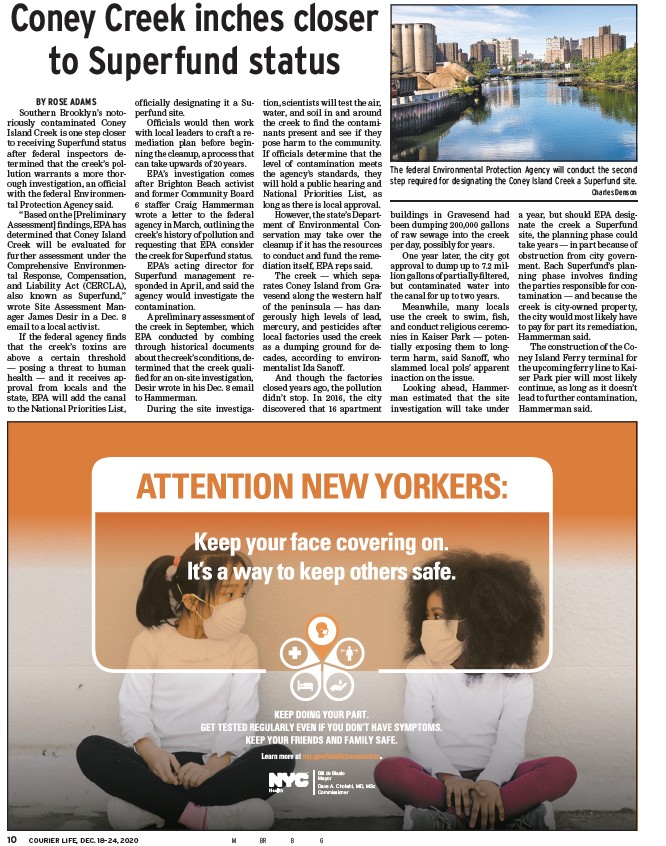
BY ROSE ADAMS
Southern Brooklyn’s notoriously
contaminated Coney
Island Creek is one step closer
to receiving Superfund status
after federal inspectors determined
that the creek’s pollution
warrants a more thorough
investigation, an offi cial
with the federal Environmental
Protection Agency said.
“Based on the Preliminary
Assessment fi ndings, EPA has
determined that Coney Island
Creek will be evaluated for
further assessment under the
Comprehensive Environmental
Response, Compensation,
and Liability Act (CERCLA),
also known as Superfund,”
wrote Site Assessment Manager
James Desir in a Dec. 8
email to a local activist.
If the federal agency fi nds
that the creek’s toxins are
above a certain threshold
— posing a threat to human
health — and it receives approval
from locals and the
state, EPA will add the canal
to the National Priorities List,
offi cially designating it a Superfund
site.
Offi cials would then work
with local leaders to craft a remediation
plan before beginning
the cleanup, a process that
can take upwards of 20 years.
EPA’s investigation comes
after Brighton Beach activist
and former Community Board
6 staffer Craig Hammerman
wrote a letter to the federal
agency in March, outlining the
creek’s history of pollution and
requesting that EPA consider
the creek for Superfund status.
EPA’s acting director for
Superfund management responded
in April, and said the
agency would investigate the
contamination.
A preliminary assessment of
the creek in September, which
EPA conducted by combing
through historical documents
about the creek’s conditions, determined
that the creek qualifi
ed for an on-site investigation,
Desir wrote in his Dec. 8 email
to Hammerman.
During the site investigation,
scientists will test the air,
water, and soil in and around
the creek to fi nd the contaminants
present and see if they
pose harm to the community.
If offi cials determine that the
level of contamination meets
the agency’s standards, they
will hold a public hearing and
National Priorities List, as
long as there is local approval.
However, the state’s Department
of Environmental Conservation
may take over the
cleanup if it has the resources
to conduct and fund the remediation
itself, EPA reps said.
The creek — which separates
Coney Island from Gravesend
along the western half
of the peninsula — has dangerously
high levels of lead,
mercury, and pesticides after
local factories used the creek
as a dumping ground for decades,
according to environmentalist
Ida Sanoff.
And though the factories
closed years ago, the pollution
didn’t stop. In 2016, the city
discovered that 16 apartment
Dave A. Chokshi, MD, MSc
COURIER L 10 IFE, DEC. 18–24, 2020 M BR B G
buildings in Gravesend had
been dumping 200,000 gallons
of raw sewage into the creek
per day, possibly for years.
One year later, the city got
approval to dump up to 7.2 million
gallons of partially-fi ltered,
but contaminated water into
the canal for up to two years.
Meanwhile, many locals
use the creek to swim, fi sh,
and conduct religious ceremonies
in Kaiser Park — potentially
exposing them to longterm
harm, said Sanoff, who
slammed local pols’ apparent
inaction on the issue.
Looking ahead, Hammerman
estimated that the site
investigation will take under
a year, but should EPA designate
the creek a Superfund
site, the planning phase could
take years — in part because of
obstruction from city government.
Each Superfund’s planning
phase involves fi nding
the parties responsible for contamination
— and because the
creek is city-owned property,
the city would most likely have
to pay for part its remediation,
Hammerman said.
The construction of the Coney
Island Ferry terminal for
the upcoming ferry line to Kaiser
Park pier will most likely
continue, as long as it doesn’t
lead to further contamination,
Hammerman said.
Coney Creek inches closer
to Superfund status
The federal Environmental Protection Agency will conduct the second
step required for designating the Coney Island Creek a Superfund site.
Charles Denson
Bill de Blasio
Mayor
Commissioner